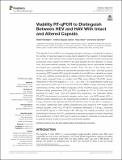Por favor, use este identificador para citar o enlazar a este item:
http://hdl.handle.net/10261/192466COMPARTIR / EXPORTAR:
 SHARE SHARE
 CORE
BASE CORE
BASE
|
|
| Visualizar otros formatos: MARC | Dublin Core | RDF | ORE | MODS | METS | DIDL | DATACITE | |

| Título: | Viability RT-qPCR to distinguish between HEV and HAV with intact and altered capsids |
Autor: | Randazzo, Walter CSIC ORCID; Vasquez García, A.; Aznar, Rosa CSIC ORCID; Sánchez Moragas, Gloria CSIC ORCID | Fecha de publicación: | 2018 | Editor: | Frontiers Media | Citación: | Frontiers in Microbiology 9 (2018) | Resumen: | The hepatitis E virus (HEV) is an emerging pathogen showing a considerable increase in the number of reported cases in Europe mainly related to the ingestion of contaminated food. As with other relevant viral foodborne pathogens, real-time reverse transcriptase polymerase chain reaction (RT-qPCR) is the gold standard for HEV detection in clinical, food, and environmental samples, but these procedures cannot discriminate between inactivated and potentially infectious viruses. Thus, the aim of this study was to develop a viability PCR method to discriminate between native, heat-, and high-pressure processing (HPP)-treated HEV using the hepatitis A virus (HAV) as a cultivable surrogate. To this end, different concentrations of viability markers (PMAxx and platinum chloride, PtCl) were screened firstly on purified viral RNA using different RT-qPCR assays. Reductions of HEV RNA signals of > 17.5, > 15.0, and > 15.5 quantification cycles (Cq) were reported for PtCl and 1.6, 2.9, and 8.4 Cq for PMAxx, clearly indicating a better performance of PtCl than PMAxx irrespective of the RT-qPCR assay used. The most efficient viability pretreatment (500 μM PtCl incubated at 5°C for 30 min) was then assessed on native, heat-, and HPP-treated HEV suspension. The optimized viability RT-qPCR discriminated successfully between native, heat-, and HPP-treated HEV, to different extents depending on the experimental conditions. In particular, approximately 2-log10 reduction was reported by PtCl-RT-qPCR at both 72 and 95°C compared to the control. Additionally, both viability pretreatments were tested for HPP-treated HAV without success, while PtCl-RT-qPCR completely eliminated (> 5.6-log10 reduction) the RT-qPCR signals of HPP-treated HEV. Although this viability procedure may still overestimate infectivity, the PtCl pretreatment represents progress to better interpreting the quantification of intact HEV, and it could be included in molecular procedures used to quantify enteric viruses in food and environmental samples. | URI: | http://hdl.handle.net/10261/192466 | DOI: | 10.3389/fmicb.2018.01973 | Identificadores: | doi: 10.3389/fmicb.2018.01973 issn: 1664-302X |
| Aparece en las colecciones: | (IATA) Artículos |
Ficheros en este ítem:
| Fichero | Descripción | Tamaño | Formato | |
|---|---|---|---|---|
| fmicb-09-01973.pdf | 567,42 kB | Adobe PDF |  Visualizar/Abrir |
CORE Recommender
PubMed Central
Citations
15
checked on 12-may-2024
SCOPUSTM
Citations
30
checked on 09-may-2024
WEB OF SCIENCETM
Citations
29
checked on 27-feb-2024
Page view(s)
164
checked on 12-may-2024
Download(s)
106
checked on 12-may-2024

